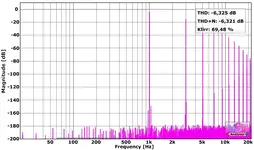Schwarzenyaeger
Formerly "Dog-In-Door"
I've got some questions about AD and DA conversions.
I read an explanation on it that showed a primitive quantization based on a 3-bit system to show a close of up the sampled voltages being adjusted the binary values. Is there somewhere where I could hear what this sounds like? Should I imagine the tone noticeably jumping in frequency when it is adjusted to the least and most significant bits?
One of the first steps of conversion is that a low-pass filter is applied to the signal to get rid of distortion caused by aliasing. The aliasing frequency is the sampling freq. minus the violating freq.
So if we sampled at 44.1kHz and our signal had a 26 Hz frequency in it, we'd end up with distortion at about the 18.1 kHz area, yes?
Also, if we assume that 20 kHz is the maximum freq. that we can hear and we're sampling at 44.1 kHz (Does anybody really sample below this?), we'd end up with a distortion at 24.1 kHz, which would (presumptuously) be irrelevant for us anyhow since we can't hear in those frequencies.
Still, might the waveform still be altered so much that it would change noticeably for us?
I read an explanation on it that showed a primitive quantization based on a 3-bit system to show a close of up the sampled voltages being adjusted the binary values. Is there somewhere where I could hear what this sounds like? Should I imagine the tone noticeably jumping in frequency when it is adjusted to the least and most significant bits?
One of the first steps of conversion is that a low-pass filter is applied to the signal to get rid of distortion caused by aliasing. The aliasing frequency is the sampling freq. minus the violating freq.
So if we sampled at 44.1kHz and our signal had a 26 Hz frequency in it, we'd end up with distortion at about the 18.1 kHz area, yes?
Also, if we assume that 20 kHz is the maximum freq. that we can hear and we're sampling at 44.1 kHz (Does anybody really sample below this?), we'd end up with a distortion at 24.1 kHz, which would (presumptuously) be irrelevant for us anyhow since we can't hear in those frequencies.
Still, might the waveform still be altered so much that it would change noticeably for us?


